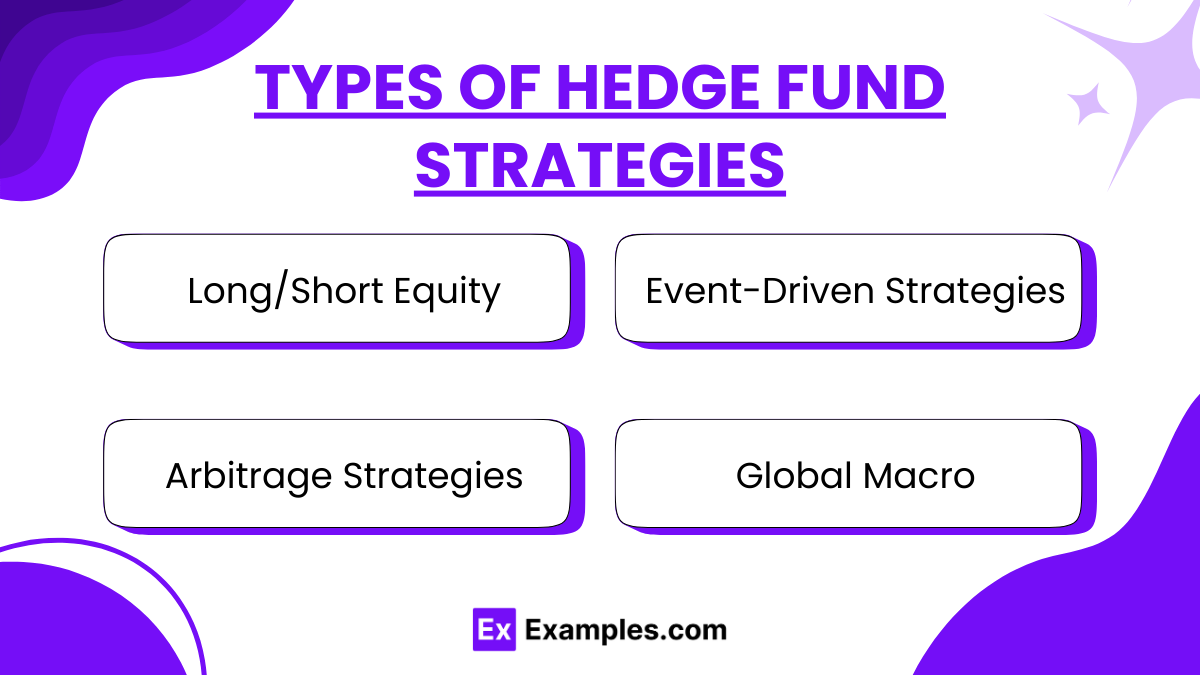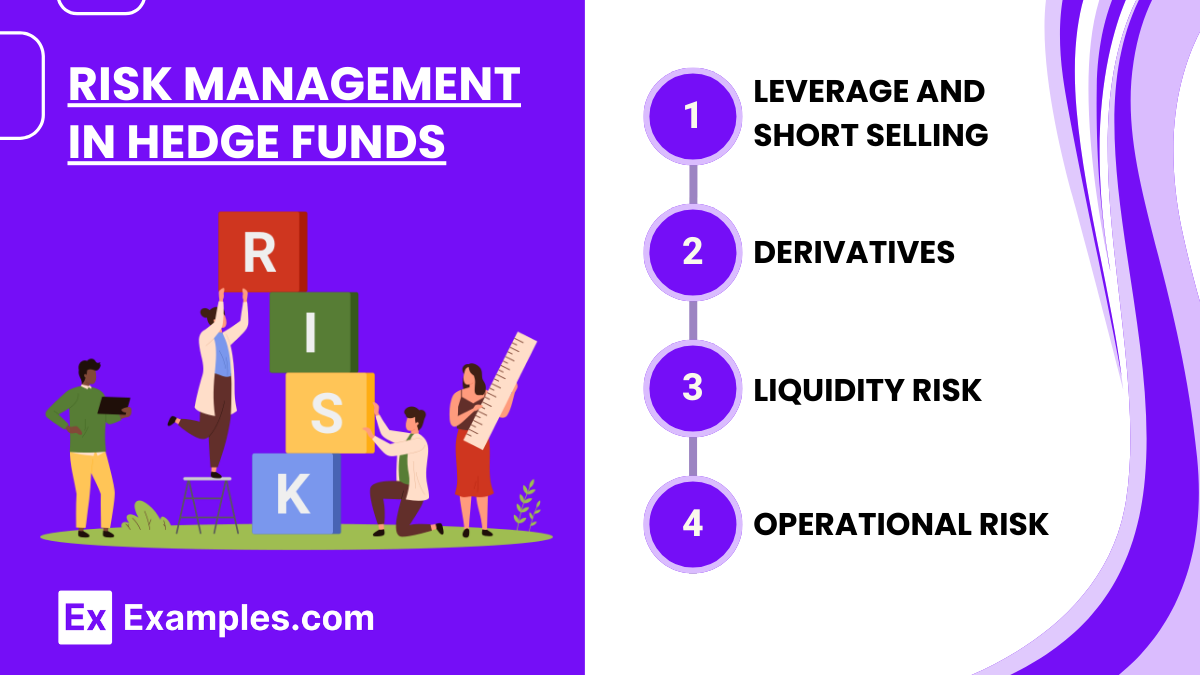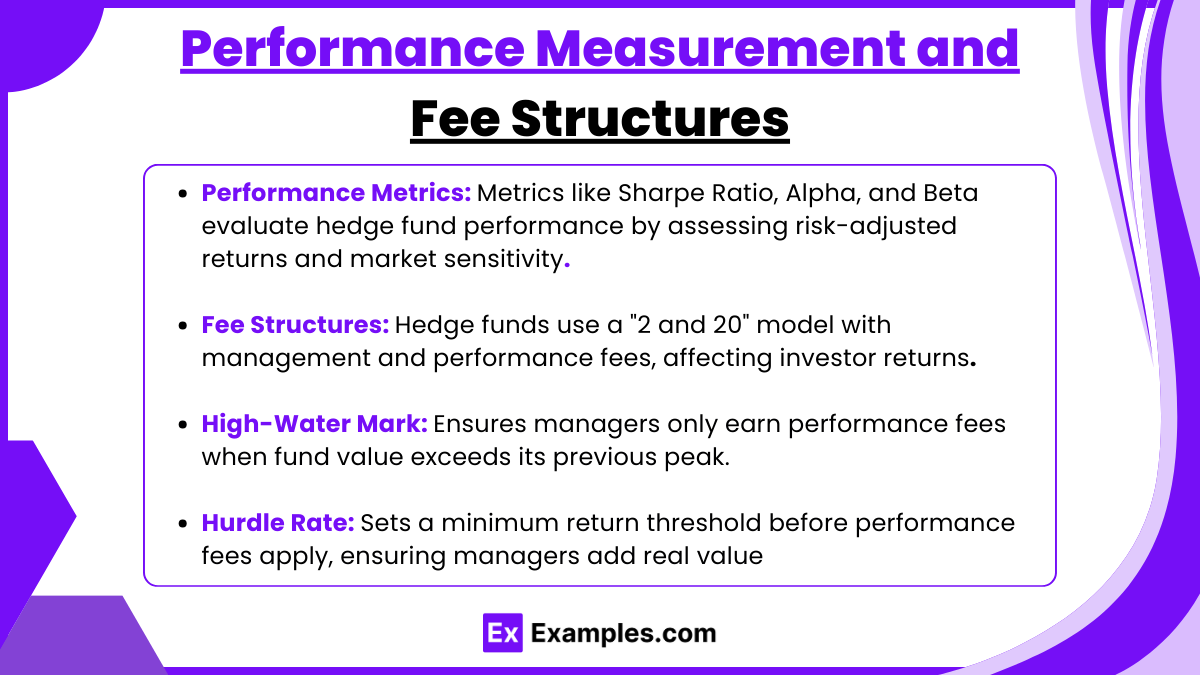Preparing for the CFA Exam demands a solid grasp of Hedge Fund Strategies, a vital part of alternative investments. Understanding various strategies, including long/short equity, market neutral, and global macro, is essential. This knowledge equips candidates with insights into risk management, leverage, and return dynamics, critical for excelling on the CFA Exam.
Learning Objective
In studying “Hedge Fund Strategies” for the CFA Exam, you should aim to understand the diverse strategies employed by hedge funds, including long/short equity, event-driven, arbitrage, and macro strategies. Analyze how these strategies manage market, liquidity, and operational risks while seeking superior risk-adjusted returns. Evaluate the role of leverage, short-selling, and derivatives within these strategies to enhance portfolio performance. Additionally, explore the regulatory considerations, fee structures, and performance measurement unique to hedge funds. Apply this knowledge to assess how hedge funds diversify investment portfolios and contribute to global financial markets, preparing you for complex investment scenarios on the CFA Exam.
Types of Hedge Fund Strategies

1. Long/Short Equity
Long/Short Equity is one of the most common hedge fund strategies. It involves buying stocks (taking a “long” position) that are expected to increase in value and selling stocks (taking a “short” position) that are expected to decrease. By balancing long and short positions, this strategy aims to profit from both rising and falling stock prices.
- Goal: To generate returns by identifying mispriced securities.
- Example: A manager might go long on undervalued tech stocks while shorting overvalued financial stocks, aiming to profit regardless of broader market direction.
2. Event-Driven Strategies
Event-Driven Strategies seek to profit from corporate events, such as mergers, acquisitions, restructurings, or bankruptcies. These events can create temporary price inefficiencies, which hedge funds exploit for potential gains.
- Subtypes:
- Merger Arbitrage: Involves taking positions in merging companies, typically buying the target’s stock and shorting the acquirer.
- Distressed Securities: Focuses on companies undergoing financial distress or restructuring, buying undervalued securities with recovery potential.
- Activist Investing: Involves buying significant shares in companies to influence management decisions for increasing shareholder value.
- Goal: To capitalize on price fluctuations and volatility caused by major corporate actions.
3. Arbitrage Strategies
Arbitrage Strategies aim to exploit price differences between related securities. These strategies involve taking offsetting positions in correlated assets to earn profit from temporary mispricings.
- Subtypes:
- Convertible Arbitrage: Involves buying convertible bonds (which can be converted into equity) and shorting the underlying stock to exploit price discrepancies.
- Fixed-Income Arbitrage: Focuses on price differences between fixed-income securities with similar characteristics, aiming to profit from interest rate or yield differences.
- Goal: To generate low-risk returns by arbitraging price inefficiencies across markets or asset classes.
4. Global Macro
Global Macro strategies focus on large-scale economic and geopolitical trends across various markets and asset classes, such as equities, bonds, currencies, and commodities. Managers analyze economic indicators, global events, and government policies to predict market movements and allocate assets accordingly.
- Approach: This strategy may include taking long or short positions in diverse markets, often using leverage or derivatives to amplify returns.
- Example: A fund might take a position on the direction of the U.S. dollar based on expected interest rate changes by the Federal Reserve.
- Goal: To profit from global economic trends and shifts, often taking on higher risk in exchange for the potential of substantial returns.
Risk Management in Hedge Funds

1. Leverage and Short Selling
Hedge funds frequently use leverage (borrowing to invest more than the initial capital) to amplify potential returns. While leverage can significantly boost gains, it also increases the potential for losses. Managing leverage is therefore critical, as excessive leverage can lead to substantial risks if the market moves unfavorably.
- Example: A hedge fund might borrow capital to double its investment in a promising asset. If the asset performs well, returns are magnified; however, if it declines, losses are equally amplified.
- Risk Management: Hedge funds set leverage limits and maintain liquidity buffers to prevent forced liquidation of assets during downturns.
Short Selling, or betting against a security’s price, is another common technique that introduces risk, particularly if prices unexpectedly rise instead of fall. Managing short positions requires close monitoring to avoid significant losses if market conditions change.
2. Derivatives
Derivatives like options, futures, and swaps are instrumental for hedging (reducing risk exposure) or speculation (increasing exposure to potential returns). Hedge funds use derivatives to protect against adverse market movements without having to sell off primary assets, maintaining both risk control and portfolio balance.
- Hedging: Derivatives can be used to offset potential losses. For example, put options might be bought to protect long equity positions from market downturns.
- Speculation: Hedge funds may use derivatives to gain exposure to assets without holding them directly, enabling greater flexibility and leverage.
Risk Management: Monitoring derivative exposure and potential counterparty risks (risk that the other party in a derivatives contract might default) is essential, as derivative positions can introduce complex, layered risks.
3. Liquidity Risk
Liquidity risk is the risk that a hedge fund may not be able to sell assets quickly enough to meet redemption requests from investors or other obligations without significantly affecting asset prices. Some hedge fund investments, like real estate or private equity, are less liquid and can be challenging to sell rapidly without incurring losses.
- Risk Management Techniques:
- Lock-Up Periods: Many hedge funds have initial lock-up periods, during which investors cannot withdraw funds, allowing managers to hold less liquid assets without the pressure of immediate redemptions.
- Redemption Gates and Fees: Redemption gates limit the amount investors can withdraw during a certain period, and redemption fees discourage frequent withdrawals, stabilizing fund liquidity.
These measures enable hedge funds to maintain a more stable investment approach, even if individual assets lack liquidity.
4. Operational Risk
Operational risk refers to the risk of losses stemming from inadequate or failed internal processes, people, systems, or external events. This includes risks related to compliance, cybersecurity, infrastructure, and other operational aspects. Hedge funds face significant operational risk, especially due to the complex nature of their strategies and high-value transactions.
- Risk Management Techniques:
- Strong Governance and Internal Controls: Implementing robust internal procedures, checks, and balances ensures smooth operations and minimizes errors.
- Compliance Monitoring: Adhering to regulatory requirements is essential, as non-compliance can lead to fines, legal costs, and reputational damage.
- Cybersecurity Measures: Hedge funds safeguard sensitive data and client information by implementing cybersecurity protocols and continuous monitoring to prevent data breaches or attacks.
By mitigating operational risk, hedge funds protect themselves from disruptions that could affect their performance and reputation.
Performance Measurement and Fee Structures

1. Performance Metrics
Hedge funds use several metrics to evaluate their performance, focusing on both return and risk. These metrics help investors assess whether a fund is achieving adequate returns given its level of risk.
- Sharpe Ratio: Measures the risk-adjusted return by comparing excess returns (returns above the risk-free rate) to the fund’s volatility. A higher Sharpe ratio indicates better risk-adjusted performance.
- Alpha: Represents the fund’s outperformance (or underperformance) relative to a benchmark. A positive alpha suggests the fund has added value beyond what would be expected based on the market’s movement.
- Beta: Indicates the fund’s sensitivity to market movements. A beta above 1 implies the fund is more volatile than the market, while a beta below 1 suggests lower volatility.
These metrics allow investors to assess if the hedge fund manager is delivering superior returns relative to the risk taken, enabling more informed investment decisions.
2. Fee Structures
Hedge fund fee structures are unique compared to traditional funds, often involving two components:
- Management Fee: This fee is typically a fixed percentage (often around 2%) of assets under management (AUM), charged annually. It covers the operational costs of managing the fund, including salaries, research, and overhead. Regardless of performance, the management fee is collected to ensure consistent cash flow for the fund manager.
- Performance Fee: A performance fee (often 20%) is charged on any profits generated by the fund, aligning the manager’s incentives with investor success. This fee structure, commonly known as “2 and 20,” encourages managers to pursue high returns while taking calculated risks.
Together, these fees can have a substantial impact on investor returns, particularly during high-profit years.
3. High-Water Mark
A High-Water Mark ensures that hedge fund managers only earn performance fees if the fund’s value exceeds its previous highest level. If a fund incurs losses, managers must recover those losses before they can charge performance fees again.
- Example: If a fund’s value drops, the manager must bring it back up to the high-water mark before collecting performance fees, protecting investors from paying fees on recovery gains.
This protects investors from paying performance fees multiple times on the same gains, promoting fair compensation for managers.
4. Hurdle Rate
A Hurdle Rate is the minimum return level the fund must achieve before performance fees are applied. It ensures that investors only pay fees on returns that exceed a specified threshold, which could be a fixed percentage or tied to an index or benchmark.
- Example: If a fund has a hurdle rate of 5%, performance fees are only charged on returns above this threshold, ensuring that the manager adds real value before receiving performance compensation.
Hurdle rates encourage managers to exceed basic returns, aligning their goals with investor expectations and market performance.
Examples
Example 1
A hedge fund utilizing a long/short equity strategy might invest in undervalued technology stocks while shorting overvalued financial stocks. By balancing these positions, the fund aims to profit from sector-specific mispricing and hedge against broader market risks.
Example 2
An event-driven hedge fund identifies a merger announcement between two companies. The fund buys shares in the target company, expecting the stock price to rise as the merger finalizes. If successful, the fund profits from the price appreciation in the target company’s stock.
Example 3
A hedge fund focusing on global macro strategy predicts that interest rates in Europe will rise due to upcoming economic policies. The fund takes short positions in European government bonds, expecting bond prices to decline as interest rates increase, generating profit from macroeconomic shifts.
Example 4
A convertible arbitrage hedge fund buys convertible bonds of a company and simultaneously shorts the company’s stock. The bond can later be converted into stock if the stock price increases, allowing the fund to capitalize on the conversion feature while mitigating risk through the short position.
Example 5
A distressed securities hedge fund invests in bonds of a company undergoing financial restructuring. The fund believes the company’s situation will improve, resulting in an increase in bond value. By investing at a discount, the fund profits if the company successfully navigates its restructuring
Practice Questions
Question 1
Which of the following best describes a long/short equity strategy in hedge funds?
A. Investing only in undervalued stocks in various sectors
B. Shorting all stocks in a single sector to hedge market risk
C. Buying undervalued stocks while shorting overvalued stocks
D. Buying and holding only high-dividend stocks
Answer: C. Buying undervalued stocks while shorting overvalued stocks
Explanation: A long/short equity strategy involves taking long positions in undervalued stocks and short positions in overvalued ones. This allows the fund to capitalize on stock mispricing while reducing exposure to overall market movements. Other options describe strategies that do not involve both long and short positions based on stock valuation.
Question 2
An event-driven hedge fund typically aims to profit from which of the following scenarios?
A. Changes in currency exchange rates
B. Mergers, acquisitions, or bankruptcies
C. Stock price trends based on technical analysis
D. Macro-level economic shifts
Answer: B. Mergers, acquisitions, or bankruptcies
Explanation: Event-driven hedge funds focus on opportunities created by corporate events such as mergers, acquisitions, and bankruptcies. These events can cause short-term price fluctuations, which the fund seeks to exploit. Macro-level economic shifts and currency changes are typically associated with global macro strategies, while technical analysis relates to a different investment approach.
Question 3
A convertible arbitrage strategy in hedge funds involves which of the following tactics?
A. Buying convertible bonds and shorting the company’s stock
B. Buying stocks in a sector and hedging with index futures
C. Investing only in bonds expected to appreciate in value
D. Shorting convertible bonds while buying high-dividend stocks
Answer: A. Buying convertible bonds and shorting the company’s stock
Explanation: A convertible arbitrage strategy involves purchasing a company’s convertible bonds (which can be converted into stock) and shorting the company’s stock. This approach allows the hedge fund to profit from the bond’s conversion feature while managing risk through the stock short. Other options do not accurately describe convertible arbitrage.

